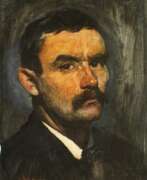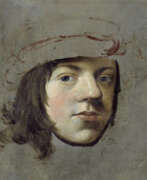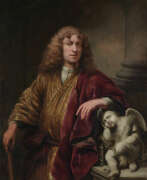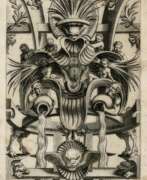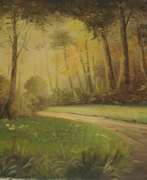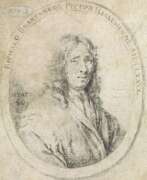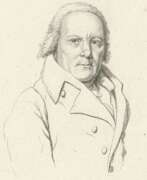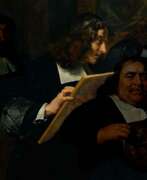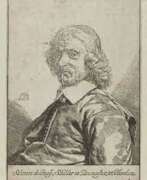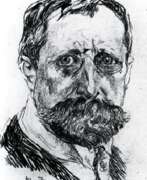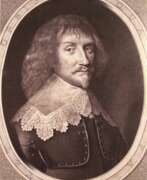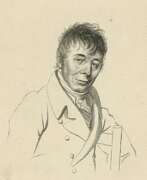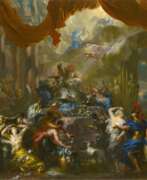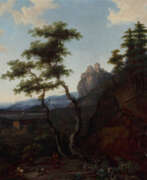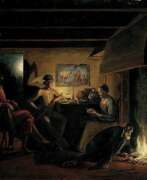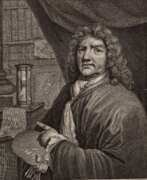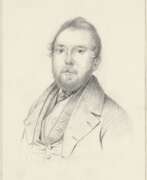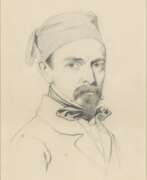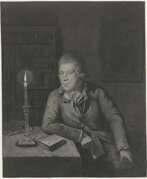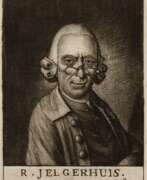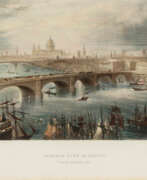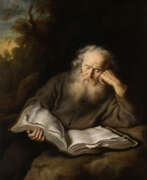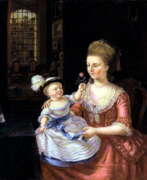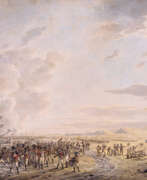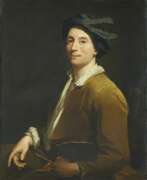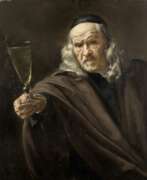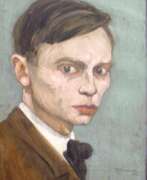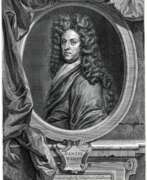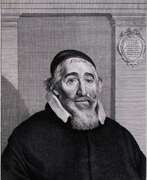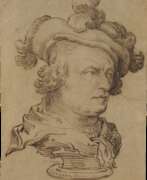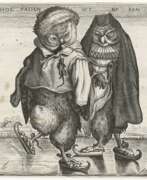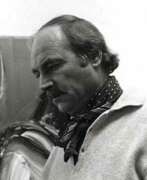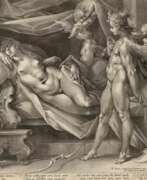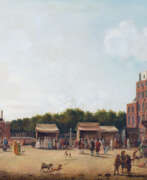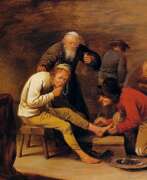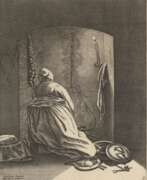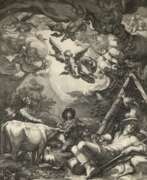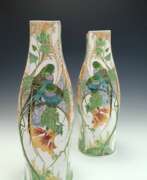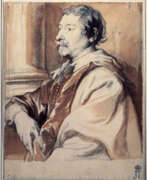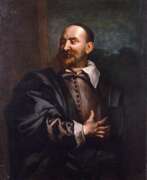Engravers The Netherlands
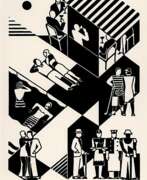

Gerd Arntz was a 20th-century German artist known for his skillful woodcut prints. A member of the Cologne Progressives—a group concerned not just with social and political issues, but also with the public’s ability to understand these concepts—Arntz sought to use his art as a method of delivering crucial information to the masses. Over the course of his life, he designed approximately 4,000 pictograms known as ISOTYPEs, or International System of Typographic Picture Education, a unique form of symbolized data from industries, politics, and economic phenomena intended for use by those who could not read.
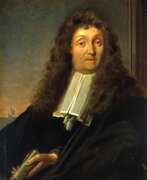

Ludolf Bakhuizen was a Dutch painter of the 17th and early 18th centuries. He is known as an outstanding master of seascapes. Bakhuizen also painted biblical themes and portraits of his contemporaries as well as engravings and miniature models of ships.
Ludolf Bakhuizen is considered one of the best marine painters of the Golden Age of Dutch painting. Among the admirers of his work were many influential European rulers, including the Russian Tsar Peter the Great. The master met Peter I, who visited Amsterdam in the mid-1690s and, according to contemporaries, even managed to give some painting lessons to the Russian tsar. In addition, Вakhuizen made models of all kinds of ship designs on commission from Peter the Great.
Toward the end of his life, the Amsterdam authorities honored Bakhuizen by opening his own gallery on the top floor of the City Hall for his achievements in the fine arts. The best masterpieces of his work are now preserved in museums in the Netherlands, Germany, England, France, and Italy.
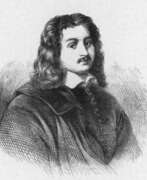

Nicolaes Pieterszoon Berchem was a highly esteemed and prolific Dutch Golden Age painter of pastoral landscapes, populated with mythological or biblical figures, but also of a number of allegories and genre pieces.
He was a member of the second generation of "Dutch Italianate landscape" painters. These were artists who travelled to Italy, or aspired to, in order to soak up the romanticism of the country, bringing home sketchbooks full of drawings of classical ruins and pastoral imagery. His paintings, of which he produced an immense number, (Hofstede de Groot claimed around 850, although many are misattributed), were in great demand, as were his 80 etchings and 500 drawings. His landscapes, painted in the Italian style of idealized rural scenes, with hills, mountains, cliffs and trees in a golden dawn are sought after. Berchem also painted inspired and attractive human and animal figures (staffage) in works of other artists, like Allaert van Everdingen, Jan Hackaert, Gerrit Dou, Meindert Hobbema and Willem Schellinks.


Valentijn Bing was a Dutch painter, illustrator and lithographer.
Bing painted genre scenes and cityscapes, portraits, as well as paintings on religious themes. He is best known for his sketchbooks depicting the costumes and customs of the Netherlands, which are pictorial descriptions of local dress and events such as carnival, ice skating, cheese making, and weddings. This work was published in 1857 in collaboration with the lithographer Jan Braet von Überfeldt (1807-1894).
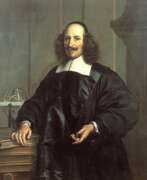

Jan (Joan) Willemsz. Blaeu was a Dutch cartographer, publisher and judge.
Jan was born into the family of the cartographer and publisher Willem Janszoon Blaeu (1571-1638). He studied in Leiden, where he earned a doctorate in law, and in Padua. He then began to assist his father, who was engaged in the manufacture of globes and maps. After his father's death, Jan, together with his brother Cornelius, continued his work, and succeeded him as cartographer for the Dutch East India Company.
In 1651 Blaeu was elected to the Amsterdam city council and later appointed as a judge. At the same time, he was engaged in his publishing business: he continued to publish volumes of Atlas novus, which contained maps of English counties and, for the first time, an atlas of Scotland, as well as one volume of maps of the Far East.
Blaeu did not have time to complete his most ambitious project, but it made him famous as the author of the famous 11-volume Dutch atlas. Based on his previous maps, Blaeu created the Great Atlas (Atlas Maior) - it contained nearly 600 maps and a total of 3,000 pages of Latin text - and was published in 1662. Blaeu's maps were groundbreaking for their time because they were created in accordance with the heliocentric theories of Nicolaus Copernicus.
In 1672, a great fire in Amsterdam destroyed Blaeu's workshop, and the cartographer died a year later, apparently never recovering from this stroke of fate.
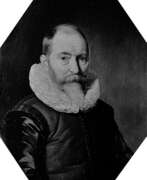

Willem Janszoon Blaeu was a Dutch cartographer and map publisher.
Willem studied astronomy and cartography under the Danish astronomer Tycho Brahe and even discovered the variable star P Swan in 1600. A little later Blaeu settled in Amsterdam, where he began making globes and also began producing land and sea maps, including a 1605 world map. In 1629 he managed to acquire the printing plates of the cartographer Jodok Hondius, with which he published his own atlas.
In 1633, Willem Blaeu was appointed cartographer of the Dutch Republic, as well as the official cartographer of the Dutch East India Company. Blau built up a large collection of maps and conducted an extensive publishing business. After Willem's death, his sons Jan Blaeu (1596-1673) and Cornelius Blaeu successfully continued his work. But in 1672, during a fire in Amsterdam, Blaeu's workshop was destroyed, and the company founded by Willem Blaeu ceased to exist in 1698.
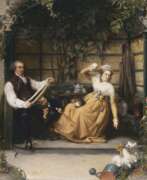

David Bles was a 19th-century painter from the Northern Netherlands. According to the Netherlands Institute for Art History, at the age of thirteen Bles was talented enough to be accepted at the Hague Academy. He attended classes from 1834 to 1837 and from 1838 to 1841. He became a pupil of the painter Cornelis Kruseman and his nephew Jan Adam Kruseman. Bles then travelled to France to study with Joseph-Nicolas Robert-Fleury in Paris. He remained in Paris until 1843 after which he settled in The Hague, though he was a member of the Royal Academy in Amsterdam between 1845 and 1899. He painted scenes from the history of Dutch painting and is best known for portraits and genre paintings.
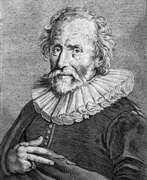

Abraham Bloemaert was a Dutch painter, draughtsman, and printmaker from the Golden Age of Dutch painting, one of the founders of the Guild of St. Luke in Utrecht. Bloemart was a caravagist. He painted mainly landscapes, mythological and biblical scenes, and pastoral works.
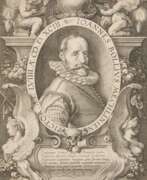

Hans Bol was a Flemish artist renowned for his miniature paintings and prints. Born in Mechelen, Bol was a pivotal figure in the transition from the world landscape tradition to a more realistic portrayal of nature. His early works as a 'water-verwer' offered affordable wall decorations but were susceptible to copying. This led him to create intricate miniatures on parchment, a medium less easily replicated.
Bol's influence on landscape art in the Low Countries is significant. His realistic landscapes, often featuring biblical scenes or daily life, showed a departure from imaginary landscapes, which was common at the time. This shift was partly due to the influence of Pieter Bruegel the Elder. Bol's completion of the Four Seasons series, initially started by Bruegel, established him as a master of landscape art, blending detailed observation with imaginative elements.
Notably, Bol's works are present in prestigious institutions such as the Metropolitan Museum of Art, where pieces like "The Prodigal Son" and various landscapes reflect his mastery of pen, ink, and wash. His artworks, like the "Landscape with a View of Antwerp," stand testament to his skill in capturing the essence of the Dutch landscape, influencing a generation of Dutch painters.
For collectors, auctioneers, and art connoisseurs, Hans Bol's legacy offers a glimpse into the evolution of landscape painting. His works not only adorned the homes of the affluent during his time but continue to be celebrated for their historical and artistic value.
To stay informed about sales and auction events featuring Hans Bol's masterpieces, sign up for updates. By subscribing, you will receive notifications only for new product sales and auction events related to this eminent artist, ensuring you don't miss the opportunity to own a piece of art history.
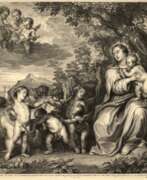

Schelte Adamsz Bolswert was a leading Dutch engraver, noted for his works after Rubens and Van Dyck. Both he and his older brother, Boetius à Bolswert, worked in Amsterdam and Haarlem before settling in Antwerp. For the last five years of his life Boetius worked exclusively on engravings after Rubens. Bolswert's plates were worked entirely with the graver, and he does not seem to have made any use of the drypoint. The freedom which this excellent artist handled the graver, the picturesque roughness of etching, which he could imitate without any other assisting instrument, and the ability he possessed of distinguishing the different masses of colours, have always been admired by the conoisseurs".
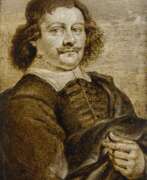

Jan Dirksz Both was a distinguished Dutch painter, draughtsman, and etcher renowned for his pivotal role in the evolution of Dutch Italianate landscape painting. His journey into the arts began in Utrecht, learning from his father before becoming a pupil of Abraham Bloemaert. Both's career took a significant turn when he, alongside his brother Andries, ventured to Rome, absorbing the influence of Claude Lorrain and contributing to projects such as the Buen Retiro Palace in Madrid.
By the mid-1640s, Jan had returned to Utrecht, further honing his craft to produce expansive landscapes illuminated by a Mediterranean glow, notable for their mixture of realism in the foreground against idyllic backgrounds. Noteworthy pieces include "Landscape with Bandits Leading Prisoners" and "Judgement of Paris," showcasing his mastery in blending naturalistic details with mythological and religious figures. His landscapes, characterized by their golden light and imaginative vistas, earned him a place among the leading masters of the Italianate trend in Dutch landscape painting.
Jan Both's legacy is preserved in prestigious collections worldwide, including the Fitzwilliam Museum, the Hermitage, the Kunsthistorisches Museum, the Louvre, and the National Gallery, among others. His work reflects a significant Italian influence merged with his native Dutch sensibilities, marking him as a key figure in the 17th-century art scene.
For collectors and experts in art and antiques, Jan Dirksz Both's oeuvre offers a fascinating glimpse into the blend of Dutch and Italian influences that characterize the Italianate landscape painting tradition. His contributions not only enriched Dutch art but also provided a bridge between the Renaissance and Baroque periods, capturing the beauty of landscapes with a unique, poetic light.
To explore more about Jan Dirksz Both's contributions to art and to stay informed about exhibitions or sales featuring his work, signing up for updates from art institutions can offer exclusive insights into the world of this influential Dutch painter. This subscription ensures enthusiasts and collectors are well-informed about developments related to Both's oeuvre, enhancing their appreciation and understanding of his artistic legacy.
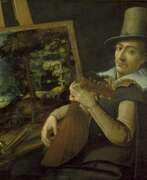

Paul Bril was a prominent Flemish painter, best known for his significant contributions to landscape painting. Born around 1554 in Antwerp, he later moved to Rome, where he became a central figure in the art scene, influencing the Italian and Northern European landscape painting traditions.
Paul Bril's early works were steeped in the Flemish manner, exhibiting a picturesque arrangement of landscape elements with dramatic contrasts of light and dark. His style evolved during his stay in Rome, influenced by the work of Annibale Carracci and Adam Elsheimer. By around 1605, Bril's compositions became more serene and classical, showcasing calmer transitions from foreground to background and embracing pastoral and mythological themes.
Paul Bril's contributions extended beyond his paintings. He was a respected figure in Rome's art community, becoming the first foreign director of the Accademia di San Luca in 1621. His patrons included some of the most influential families in Rome, and his work was sought after by collectors and fellow artists. Bril's influence was profound, impacting future generations of artists, including the Dutch Italianates and genre painters active in Rome.
His works can be found in prestigious galleries worldwide, illustrating his enduring legacy in the art world. For collectors and art and antiques experts, Paul Bril's work represents a significant period in the evolution of landscape painting, blending Flemish traditions with Italian classicism.
For those interested in exploring the captivating landscapes and historical significance of Paul Bril's art, staying informed about new product sales and auction events is essential. Signing up for updates can provide valuable insights and opportunities to acquire pieces associated with this influential artist.
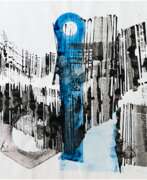



Jacob Cats was a Dutch painter, printmaker and graphic artist.
He was famous for his urban landscapes and landscapes with realistic portrayals of people and animals. His works were distinguished for their originality, poetic rendering of the features of nature and depth.
His works are represented in almost all major public collections in the Netherlands.
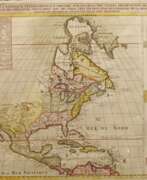

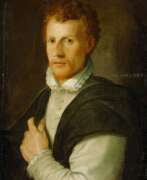

Cornelis Cort, also known as Cornelio Fiammingo, was a Dutch engraver and draughtsman. He began his career in the Northern Netherlands, but later moved to Venice and lived in Titian's house. Cort produced engravings based on Titian's works and became renowned for his copperplates of various subjects. He traveled back and forth between Italy and the Netherlands, establishing a school in Rome and circulating works of famous artists. Cort's impressive output includes over 150 engravings.


Reinier Craeyvanger was a 19th-century Dutch painter and etcher who was also a gifted musician. He etched his own sketches and collaborated with publishers on prints. He is also known for genre works and copies of old masters. He was a member of Arti et Amicitiae and served as chairman for five years. In 1848 he was one of the founders of the "Haagse Etsclub", a club for etchers in The Hague, where he lived a few years until 1850.


Aelbert Jacobsz. Cuyp was a Dutch Baroque painter, graphic artist and printmaker.
Aelbert is the successor of a dynasty of painters from Dordrecht. He was one of the leading Dutch landscape painters of the Dutch Golden Age. A pupil of his father, the painter Jacob Gerritsz. Cuyp (1594-1651), he is known primarily for his landscapes of the Dutch countryside in the light of early morning or late evening. But Aelbert Cuyp also painted canvases on biblical, mythological, and historical themes, still lifes, and portraits. The Italian style is evident in his works.


Justus Danckerts I was a Dutch engraver and print publisher who along with other members of the Danckerts family created one of the leading Dutch geographical map and atlas publishing houses. Justus Danckerts was the son of Cornelis Danckerts I (1603-1656), who established the Danckerts cartographic family business in Amsterdam. After producing in the early 1680s over 20 folio-sized atlas maps, he published in 1686-1887 the first Danckerts atlas. In 1690, another 26-sheet geographical atlas was published; between 1698 and 1700, a 60-sheet atlas was completed. Its map sheets and plates were used by various publishers until the middle of the 18th century.
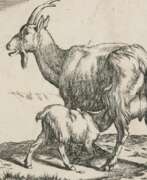

Marcus de Bye (sometimes spelt de Bie or de Bije) was a Dutch painter and engraver. He learnt to paint under Jacob van der Does, and produced some landscapes with animals in the style his teacher, but he is best known for his etchings of animals, after the designs of Paulus Potter and Markus Gerard II. Member of Confrerie Pictura.


Jacob de Gheyn III was a Dutch artist, painter and printmaker of the Golden Age.
He was the son of Jacob de Gheyn II, canon of Utrecht, engraver and graphic artist, a favorite royal artist who designed a garden in The Hague for the royal family. And his grandfather was a miniaturist and glass painter. De Gheyn learned etching from his father, then studied in Leiden with Constantin and Maurits Huygens. Thanks to his rich inheritance, he did not bother to work. After traveling to London and Sweden in 1620, Jacob de Gheyn III lived in The Hague and then moved to Utrecht, where he became a canon of St. Mary's Church and lived until the end of his life.
Jacob de Gheyn III patronized Rembrandt, who painted a portrait of him in 1632. This portrait has become famous in modern times for being mentioned in the Guinness Book of Records as the most frequently stolen painting and even bears the nickname "Rembrandt to take away".
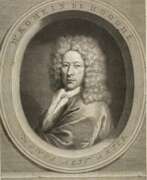

Romeyn de Hooghe was a Dutch painter, sculptor, engraver and caricaturist of the late Baroque period, writer and philosopher.
Hooghe became famous for his political caricatures of King Louis XIV of France and propaganda pamphlets in support of William of Orange. He portrayed the war against the French monarch and his allies as a struggle between freedom and religious despotism.
Romeyn de Hooghe was a superb engraver and created over 3,500 engravings during his lifetime. His most important work is Hieroglyphica of Merkbeelden der oude volkeren (Hieroglyphics or Symbols of the Ancient Peoples), where he appeared not only as a consummate master of engraving, but also as a historian, talented writer and philosopher. This book has long been regarded in Europe as one of the most authoritative sources on classical mythology. It contains 64 engravings illustrating all stages of the narrative of myths, ancient cults and beliefs, and the interpretation of scripture, a guide to medieval Europe.
Romeyn de Hooghe also illustrated books and painted large panels. During his lifetime he was widely recognized as a painter and sculptor not only in his own country but also in other European countries.


Pieter de Molijn, a distinguished Dutch Golden Age painter and engraver, was celebrated for his exceptional landscapes, genre pieces, and more. Born in London in 1595 to Flemish parents, he moved to the Netherlands, where he significantly contributed to Dutch art. Molijn was not just a painter; his talents extended to engraving, a testament to his versatility in the art world.
Pieter de Molijn's journey into art took him to Italy and then to Haarlem, where he joined the Guild of St. Luke in 1616, marking the start of a prolific career. His landscapes, known for their sweeping diagonals and tonal unity, helped pioneer a new style that influenced contemporaries and successors alike. Molijn's ability to capture the essence of the Dutch landscape made his works sought after, not just during his lifetime but also in today's art circles.
His works, like the captivating "Landscape with Figures," showcased at The Metropolitan Museum of Art, continue to fascinate art enthusiasts and collectors. Pieter de Molijn's artistry wasn't confined to landscapes alone; his genre pieces and marine scenes also garnered acclaim, reflecting his diverse skills and innovative approach.
For art collectors and experts keen on Dutch Golden Age paintings, Molijn's works represent a blend of technical mastery and artistic vision. Whether it's his detailed landscapes or compelling genre scenes, each piece invites viewers into the world he saw and experienced.
For those who appreciate the finesse of Dutch Golden Age art, staying updated on Pieter de Molijn's works is a must. Whether it's auctions, exhibitions, or private sales, sign up for updates and never miss out on the opportunity to explore or acquire Molijn's timeless masterpieces.
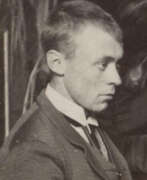

Pieter Cornelis de Moor, a Dutch artist, stands out as a versatile and innovative figure in the art world. His education at the Academy of Visual Arts in Rotterdam and the Drawing Academy in Antwerp laid the foundation for a career marked by diversity and creativity. De Moor's achievements, including a silver medal in the Prix de Rome in 1887, underline his early recognition and the promise of his artistic journey.
De Moor's artistry was not confined to a single medium; he was adept in drawing, etching, painting, watercolor, producing lithographs, and working as an illustrator. His artworks, ranging from "Dancing Women" to "Poultry on a Yard" and "An Elegant Lady Feeding Peacocks," showcase his broad thematic interests and technical skills. Notably, his works are held in prestigious collections, including the Rijksmuseum and the Dordrechts Museum.
The artist's life was rich with experiences, having worked across Europe and eventually settling in the United States. His legacy, punctuated by exhibitions in museums such as Museum Boijmans Van Beuningen and the Drents Museum, continues to captivate art enthusiasts and collectors.
For collectors and art experts, delving into the works of Pieter Cornelis de Moor offers a unique glimpse into the evolution of Dutch art. His contributions, particularly in the realm of Symbolism, highlight an era of artistic exploration and innovation.
Stay informed about new product sales and auction events related to Pieter Cornelis de Moor by signing up for updates. This subscription is your gateway to the latest acquisitions and opportunities in the world of this distinguished artist.
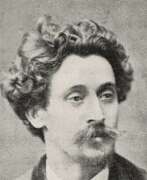

Louis Victor Antonio Artan de Saint-Martin was a Belgian marine painter. His work was influenced by the Barbizon School and the French marine painter Eugène Boudin. A convinced realist, he confined himself to the familiar North Sea, which he studied every day. He was fascinated by dramatic effects and exceptional atmospheric conditions. Just as in the paintings of the Tervuren school, his painting, created by the use of large quantities of pigment applied in copious layers or large masses skilfully distributed and then worked with a trowel, gives the work an appearance of breadth and immediacy.
Saint-Martin was one of the sixteen co-founders of the Société Libre des Beaux-Arts, an association opposed to the stylistic hegemony of the academies and salons. After 1880 he worked in a more impressionist style, and in 1881 he became a Chevalier de l'Ordre de Léopold. Two years later, the artist was awarded a gold medal at the International Colonial and Export Exhibition in Amsterdam.


Willem Drost was a notable Dutch Golden Age painter and printmaker known for his history paintings and portraits. His journey through the art world led him from his birthplace in Amsterdam to the vibrant cultural scene of Venice, where he spent his final years. Drost's work, particularly influenced by his time as one of Rembrandt's most gifted pupils, showcases a mastery of Baroque style, characterized by dramatic use of light and shadow, and a focus on realism and emotional depth.
Despite the relatively small number of works directly attributed to Drost, his legacy is significant, with several of his paintings having been mistakenly attributed to Rembrandt for centuries. This confusion underscores Drost's skill in emulating Rembrandt's style so closely that discerning between the master's and the pupil's work became a subject of scholarly investigation. Among Drost's known pieces, "Bathsheba" (1654), held at the Louvre, stands out for its sensuous portrayal of the biblical figure, showcasing Drost's ability to capture the nuanced interplay of light and shadow, as well as the psychological complexity of his subjects.
Drost's contribution to the Dutch Golden Age of painting is now more clearly recognized, with artworks such as "The Polish Rider," once thought to be by Rembrandt, suggested by some scholars as possibly being his work. While controversial, this reevaluation of Drost's contributions highlights the ongoing discussion about attribution within the art community and the importance of pupils in the studios of great masters like Rembrandt.
For collectors and experts in art and antiques, Willem Drost offers a fascinating glimpse into the world of the Dutch Golden Age, where the lines between master and pupil blur in the shared pursuit of artistic excellence. His works, housed in museums like the Ashmolean Museum in Oxford, the Metropolitan Museum of Art in New York City, and The Wallace Collection in London, continue to captivate audiences with their beauty and emotional depth.
To stay informed about new discoveries, sales, and auction events related to Willem Drost, signing up for updates from art galleries and auction houses is recommended. This ensures access to the latest information and opportunities to engage with the works of this remarkable artist who played a vital role in the legacy of the Dutch Golden Age.


Pierre Louis Dubourcq was a Dutch landscape painter, lithographer and etcher. He was a student of Jan van Ravenswaay in Hilversum in 1834 and of Andreas Schelfhout in The Hague in 1835. He mainly painted mountain and forest landscapes and he etched, drew, created watercolors and lithographs. From 1834 to 1858 he took part in the exhibitions in Amsterdam and The Hague. Prince Alexander of Orange-Nassau commissioned him to do some watercolors of the falconry hunts at Het Loo Castle. He was a member of Arti et Amicitiae, the Koninklijke Academie van Beeldende Kunsten and the Natura Artis Magistra Society.


Jacob Duck was a Dutch artist, celebrated for his etchings and paintings that vividly capture the essence of daily life, military scenes, and figures during the Dutch Golden Age. Born around 1600 in Utrecht, Jacob Duck initially trained as a goldsmith before turning his focus to painting, under the guidance of Joost Cornelisz Droochsloot. His journey took him from Utrecht to Haarlem and finally to The Hague, showcasing his adaptability and the breadth of his work across different Dutch cities.
Jacob Duck's artistry is distinguished by its intimate portrayal of soldiers and everyday scenes, marked by a keen observation of social interactions and the human condition. His works, housed in prestigious museums like the Hermitage Museum, underscore his significant contribution to art and culture, bridging the gap between the personal and the universal in the 17th century Dutch society.
One of his notable works, "A Couple in an Interior with a Fortune-Teller," housed at The Metropolitan Museum of Art, exemplifies Duck's unique approach to narrative in art. This painting diverges from the era's typical jovial depictions of fortune-tellers by presenting a scene charged with a palpable tension, reflecting Jacob Duck's ability to infuse his works with depth and complexity. The painting's intricate details and the backstory of its subjects further illuminate Duck's skill in blending storytelling with visual artistry, making him a pivotal figure in Dutch painting.
For collectors and art experts, Jacob Duck's oeuvre offers a fascinating glimpse into the Dutch Golden Age's socio-cultural landscape, characterized by a meticulous attention to detail and a profound understanding of human emotions. His legacy continues to captivate and inspire, underscoring the enduring relevance of his work in the realms of art and history.
To stay informed about new discoveries, sales, and auction events related to Jacob Duck's works, consider signing up for updates. This subscription service is designed exclusively for enthusiasts eager to deepen their appreciation of Duck's artistry, ensuring you're always in the know about opportunities to engage with his timeless creations.
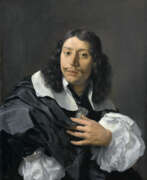

Karel Dujardin was a Dutch painter and printmaker of the Golden Age of Dutch painting.
He studied with Klaas Berchem and Paulus Potter, traveled to Italy, and lived in Lyon. In 1656 he participated in the founding of the Pictura Society in The Hague.
Dujardin painted mostly Italian landscapes, genre scenes, including scenes from rural life, portraits of elegant people and historical paintings.
Many of Dujardin's works are in the Louvre, the Hermitage (St. Petersburg), as well as in Amsterdam, The Hague, Kassel, and Berlin.


Otto Eerelman was a Dutch painter; best known for his depictions of dogs and horses. He was also a court painter and did several portraits of Wilhelmina, as Princess and Queen. His best known painting, "De paardenkeuring op de Grote Markt op de 28ste augustus", depicts an annual celebration (featuring horses) held to commemorate the lifting of the Siege of Groningen.
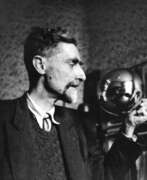

Maurits Cornelis Escher, a Dutch artist renowned for his mind-bending works that blend mathematics with visual art, has left an indelible mark on both culture and the art world. Born in 1898 in the Netherlands, Escher specialized in graphic arts, creating lithographs, woodcuts, and mezzotints that are celebrated for their inventive exploration of perspective, space, and the infinite. His ability to distort reality and challenge perceptual norms has made his works timeless, appealing to a broad audience beyond traditional art collectors and experts.
Escher's art is distinguished by its unique blend of mathematical precision and artistic imagination, making him a figure of fascination not only among artists and collectors but also mathematicians and scientists. His famous pieces, like "Relativity," "Waterfall," and "Drawing Hands," exemplify his skill in creating impossible constructions and exploring the concept of infinity through tessellation and symmetry. These works are housed in prestigious museums around the world, including the Escher Museum in The Hague, Netherlands, which is dedicated to his life and works.
For collectors and experts in art and antiques, Escher's creations offer a window into the seamless integration of science and art. His legacy continues to influence contemporary art, graphic design, and architecture, making his pieces highly sought after in the art market. The enduring appeal of Escher's work lies in its ability to engage the mind and challenge viewers' perceptions of reality, making him a pivotal figure in the world of art and culture.
To stay informed about new product sales and auction events related to Maurits Cornelis Escher, we invite you to sign up for updates. This subscription is designed specifically for enthusiasts and collectors eager to explore the fascinating intersections of art, mathematics, and perception that Escher's work represents.
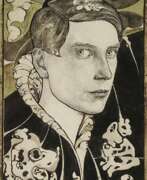

Bernard / Ben Essers was a Dutch painter. His work was part of the painting event in the art competition at the 1936 Summer Olympics. Essers' work was included in the 1939 exhibition and sale Onze Kunst van Heden (Our Art of Today) at the Rijksmuseum in Amsterdam.
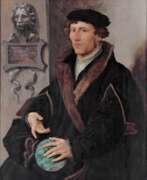

Gemma Frisius, born Jemme Reinerszoon Frisius, was a Dutch mathematician, physician, cartographer, philosopher, engraver, and master of astronomical instruments.
He taught mathematics and medicine at the University of Leuven and applied his mathematical knowledge to astronomy, geography, and map-making. Frisius participated in the creation of the latest globes and used mathematics in geodesy and navigation in new ways and invented or improved many instruments, including the cross staff, the astrolabe, and the astronomical rings (also known as "Gemma rings"). He ran a workshop for making such instruments.
Frisius is credited with being one of the founders of the Dutch school of cartography.
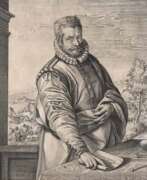

Philips Galle was a Dutch publisher, best known for publishing old master prints, which he also produced as designer and engraver. He is especially known for his reproductive engravings of paintings.
As a resident of Antwerp, Galle witnessed numerous events of the Eighty Years War, notably the siege and looting of the town in 1576 by the Spaniards, called "The Spanish Fury". This rather personal book, which was translated in several languages soon after its first publication, shows Galle as a peace-loving person who intended to stay far away from the political and military turmoil of his era.
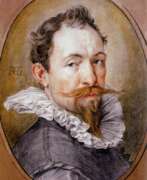

Hendrick Goltzius was a German-born Dutch printmaker, draftsman, and painter. He was the leading Dutch engraver of the early Baroque period, or Northern Mannerism, lauded for his sophisticated technique, technical mastership and "exuberance" of his compositions. According to A. Hyatt Mayor, Goltzius "was the last professional engraver who drew with the authority of a good painter and the last who invented many pictures for others to copy". In the middle of his life he also began to produce paintings.
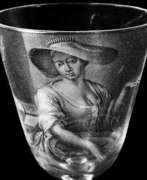

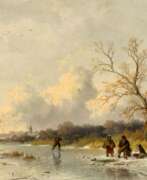

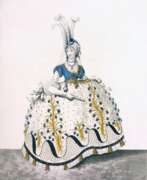

Nicolaus Heideloff, full name Nikolaus Innocentius Wilhelm Clemens van Heideloff, was a German painter and copperplate engraver and publisher.
Heideloff came from a respected family in Germany that included prominent painters and sculptors. He studied and worked in Paris, but had to flee to London during the French Revolution, where he spent 30 years of his life. Here he worked as a publisher for the most luxurious fashion magazine of the time, The Fashion Gallery, which published elaborate color copperplate prints, aquatints, and etchings. Heideloff drew many outfits for the publication for all occasions of high society.
Nikolaus Heideloff also depicted historical scenes, battles, the British navy, and caricatures for Rudolf Ackermann while he was working in London until 1814, often as hand-colored etchings.
In 1815, William I, King of the Netherlands, appointed him director of an art gallery in The Hague.
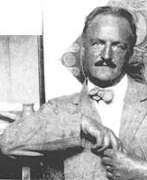

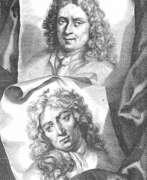

Abraham Hondius or Abraham Danielsz. Hondius or Abraham de Hondt was a Dutch painter of the Golden Age. He is known for his paintings of landscapes, hunting scenes, military genre scenes, religious scenes and portraits.
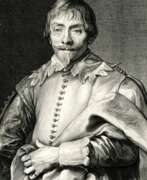

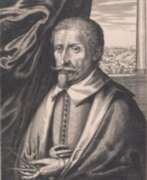

Hendrik Hondius I was a Flemish-born and trained engraver, cartographer, and publisher who settled in the Dutch Republic in 1597. Hondius was apprenticed in Brussels to Godfried van Ghelder, goldsmith to Alexander Farnese, Duke of Parma. He also studied drawing with the engraver Jan Wierix of Antwerp. At this time he started to study engraving. He applied himself to mathematics and studied perspective, architecture and the construction of fortifications. He moved to The Hague by 1597. He obtained his first print privilege for a portrait of Prince Maurits. He dedicated himself to his engraving practice. His work was very well received and he got commissions from many eminent personalities for engravings or drawings. He turned more to publishing rather than engraving and printing in the 1630s. His publications were mainly maps, books about fortifications and official portraits.[5] He also reused original plates and blocks by earlier artists for reprinting and such reprints represented almost a third of his publishing output. In the 1640s he returned to printing concentrating exclusively on etching. One of the most important publications of Hondius was the work Pictorum aliquot celebrium praecipue Germaniae inferioris Effigies (Effigies of some celebrated painters, chiefly of Lower Germany) of 1610, which was a collection of 69 portraits of mainly Netherlandish artists.
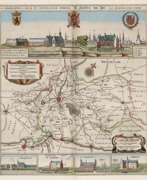

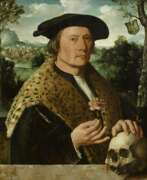

Dirck Jacobsz was a distinguished Dutch Renaissance painter, known for his contributions to the Dutch Golden Age of painting. Born into a lineage of artists, Jacobsz honed his skills under the guidance of his father, Jacob Cornelisz van Oostsanen, before establishing his own reputation in the art world. The influence of Jan van Scorel, a fellow Amsterdam painter, is evident in Jacobsz's Mannerist style, contributing to his unique artistic expression.
Jacobsz's legacy includes notable works that have been celebrated for their historical significance and craftsmanship. Among these, "The Crossbowmen" (1529) stands out as his most important piece, marking a pioneering moment in Dutch history as the first militia portrait. This work, along with his other group portraits of civic guards, showcases Jacobsz's exceptional talent in capturing the essence of his subjects, contributing to the rich tapestry of Dutch Renaissance art.
His artistic journey was deeply rooted in his family's legacy, with both his brother Cornelis and his son Jacob Dircksz continuing the tradition of painting. This continuation of the artistic profession within the family underscores the significance of the Jacobsz lineage in the Dutch art scene. Dirck's work, deeply influenced by his surroundings and the prevailing styles of his time, encapsulates the transition of artistic identity through generations, reflecting both personal and societal narratives.
Dirck Jacobsz's contributions to the world of art are commemorated through his works housed in various museums, including the Amsterdam Museum, which showcases his militia paintings and the portrait of Pompejus Occo. These pieces not only highlight Jacobsz's skill and versatility as a painter but also offer insights into the social and cultural contexts of the Dutch Renaissance.
For collectors and experts in art and antiques, Dirck Jacobsz remains a figure of interest for his historical significance and the quality of his work. To stay informed about new discoveries, sales, and auction events related to Dirck Jacobsz, consider signing up for updates from art galleries and auction houses. This will ensure you have access to the latest information and opportunities to acquire works by this renowned Dutch Renaissance painter.


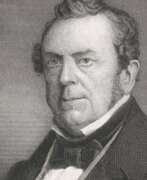

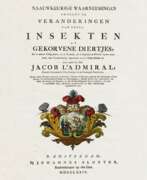

Jacob L'Admiral (Dutch: Jacob L'Admiral) was a Dutch entomologist, naturalist and artist.
L'Admiral was a gifted amateur entomologist, he was fascinated by insects from the age of ten. He studied the life cycle and metamorphosis of a number of species of butterflies, moths and other insects. And he himself made sketches and engravings showing the life cycles of insects, from egg to caterpillar, from pupa to adult, as well as their host plants. Through his work, L'Admiral was increasing the body of scientific work of the time, begun by pioneers in entomology such as Maria Sibylla Merian. In all, L'Admiral illustrated seventy metamorphoses on thirty-three engraved plates.
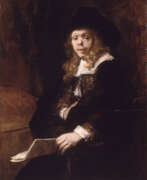

Gerard de Lairesse was a Dutch painter, printmaker, and art theorist. Known for his classical approach, de Lairesse's work marked a departure from the Baroque style prevalent in the Dutch Golden Age, leaning instead towards the neoclassicism that would dominate European art in the 18th century. His art and theories were deeply influenced by the ideals of beauty, grace, and moral edification, advocating for the selection of the most perfect manifestations of natural phenomena rather than their random imitation.
De Lairesse was not only a prolific painter but also an influential art theorist. His treatises, "Grondlegginge ter teekenkonst" (1701) and "Het groot schilderboeck" (1707), were seminal works that laid down principles of art and aesthetics that influenced not just his contemporaries but also generations of artists to come. He emphasized the importance of adhering to theoretical knowledge and the study of nature, albeit through a lens that filtered out its imperfections, to achieve ideal beauty in art.
Despite facing personal challenges, including a congenital condition that led to the loss of his sight in his later years, de Lairesse remained a central figure in the artistic and intellectual circles of Amsterdam. His lectures, delivered from his home, attracted a wide array of students and enthusiasts, eager to learn from his extensive knowledge and experience.
Today, works by Gerard de Lairesse can be found in prestigious institutions worldwide, including the Rijksmuseum and the Amsterdam Museum in the Netherlands, the Louvre in Paris, the Metropolitan Museum of Art in New York, and the National Gallery in London, among others. His legacy as the 'Dutch Poussin' speaks to his enduring influence on the evolution of European art, bridging the gap between the Baroque and the Neoclassical.
For collectors and experts in art and antiques, Gerard de Lairesse represents an intriguing study in the transition of art styles from the Baroque to Neoclassicism. His dedication to the theory and practice of art makes his work a valuable addition to any collection.
To stay informed about exhibitions, sales, and auction events related to Gerard de Lairesse's work, consider signing up for updates. This will ensure you are always up to date with the latest opportunities to engage with the remarkable legacy of this influential Dutch artist.
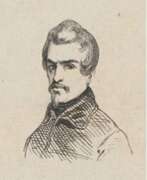

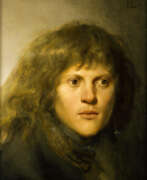

Jan Lievens was a Dutch painter, draughtsman, and engraver of the Golden Age and a member of the Guild of St. Luke in Antwerp.
It is known that while still very young, at the age of twelve, Lievens already created skillful paintings that amazed art lovers of Leiden. He was later friendly with Rembrandt, shared a studio with him, and painted in a similar style. Lievens was also a court painter in England and elsewhere.
Jan Leavens created genre scenes, landscapes, ceremonial portraits and sketches on various themes, as well as religious and allegorical images, which were already highly valued during his lifetime.
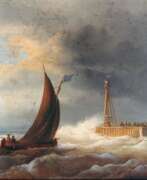

Egide (Egidius) Linnig was a Belgian painter, draughtsman and engraver. The subject matter of Linnig's work is mainly marines, ship portraits and coastal landscapes. He also had an interest in depicting the Flemish coastal towns. Linnig was an important representative of the Romantic-Realist movement in Belgian marine painting. Linnig's marine paintings are always well balanced and pay particular attention to topographical accuracy. His work provides an important testimony on the history of seafaring since he worked during the pivotal period that marked the transition from sailing ships to steamships. Linnig trained early on as an etcher and was one of the first to practise this art as an autonomous genre. He is regarded as one of the first realistic engravers in Belgium. His etchings, while technically finished, preserve a character of free and swift execution.
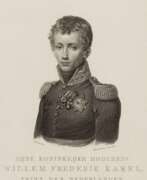

Evert Maaskamp was a Dutch artist and engraver, publisher and print dealer.
In addition to publishing geographical publications, topographical maps and engravings, Maaskamp produced very high quality illustrated works on sheet metal. Throughout his career he collaborated with the English artist Charles Howard Hodges, whose influence is evident in many of Maaskamp's engravings.
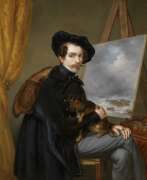

Johan Hendrik Louis Meijer was a Dutch painter, etcher, lithographer, and draftsman. He painted in the Romantic tradition and is best known for his seascapes. Meijer received his first training in painting from Westenberg and then continued his studies under JW Pieneman. He went through all the classes at the Royal Academy of Art in Amsterdam. In 1827 he left for France where he practiced landscape painting. In 1831 he returned to Holland. It was there that he first occupied himself with the profession of sea painting with the happy result that he devoted himself entirely to it.
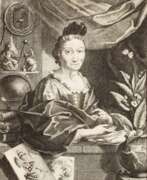

Maria Sibylla Merian was a German-born naturalist and artist renowned for her contributions to entomology and botanical art. Born in Frankfurt am Main in 1647, Merian gained recognition for her detailed studies and illustrations of insects and plants, focusing on their life cycles and metamorphosis, which significantly advanced the field of entomology.
Maria Sibylla Merian's journey into the world of natural history began in her hometown of Frankfurt, where she started studying insects, particularly their metamorphosis. Her marriage to Johann Andreas Graff, an artist's apprentice, eventually took her to Nuremberg, where she continued her work and published her findings. Despite personal challenges, including an unhappy marriage, Merian's dedication to her studies remained unwavering.
A pivotal moment in Merian's life was her association with the Labadist community, where she delved deeper into her studies. Her time with the Labadists in Friesland allowed her to study a variety of species, further enriching her scientific endeavors. Merian's relentless pursuit of knowledge eventually led her to Amsterdam, a hub of scientific inquiry and trade, where she was exposed to a vast array of specimens from across the globe.
Maria Sibylla Merian's most ambitious expedition was to Suriname in South America, where she studied and documented the region's diverse flora and fauna. Her observations and illustrations from this expedition were groundbreaking, providing valuable insights into the natural world. Merian's works, including her detailed engravings and illustrations, not only captivate with their beauty but also serve as valuable scientific records. Her legacy is preserved in institutions like the National Museum of Women in the Arts, which houses some of her remarkable engravings.
Maria Sibylla Merian's life and work exemplify the profound impact of combining art and science, leaving an indelible mark on both fields. Her dedication to observing and documenting the natural world continues to inspire scientists and artists alike.
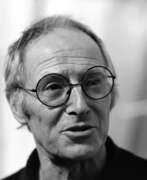

Lei Molin or Leopold Hubertus Molin was a Dutch painter, draftsman, engraver, and sculptor.
He was educated at the School of Applied Arts in Maastricht and at the Académie Julian in Paris. In the early period Molin worked in the style of Impressionism. Later, while living in North Holland, he joined the so-called Amsterdam Limburgers.


Paulus Potter was a Dutch painter who specialized in animals within landscapes, usually with a low vantage point.
Before Potter died of tuberculosis at the age of 28 he succeeded in producing about 100 paintings, working continuously.
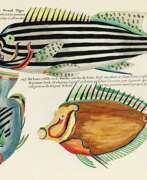

Louis Renard was a Dutch painter, printmaker and book publisher born in France.
Renard published map atlases and illustrated works of natural history popular in 18th-century Europe. In Amsterdam he acquired many cartographic plates by Frederick de Wit, which he combined with minor updates and corrections into an Atlas of Navigation and Commerce and published in 1715. He later sold the plates to R. & J. Ottens, who republished it in 1745.
In 1718 -1719 Renard published the first edition of his most famous multi-volume work, Poissons, écrevisses et crabes... que l'on trouve autour des Isles Moluques, et sur les cotes des Terres Australes ("Fish, crayfish and crabs, of varied colors and unusual forms, which are found around the Moluccas Islands and on the coasts of the southern lands."). This book was the world's first encyclopedia of fish illustrated in color. While working on it, Renard copied drawings by other artists, notably the talented Dutch artist Samuel Fallors. The result was 460 hand-colored copperplate prints.
The creatures in Renard's book are so fanciful that they may seem fictional, but only about 10 percent are, including the depiction of a mermaid. Most likely, these fantasies were included for the sake of attracting buyers. The work is now believed to be an important part of eighteenth-century scientific literature.
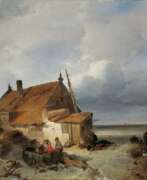

Charles Rochussen was a 19th-century painter from the Netherlands, who was also known as an illustrator and printmaker. While still a child, Charles showed a talent for drawing; between 1831 and 1834 he produced watercolor studies of birds. In 1837 he enrolled at the academy in The Hague, where he was taught by Wijnand Nuijen andAnthonie Waldorp. During his Hague period, which lasted until 1843 (or, according to some sources, 1846), he painted landscapes and beach and village views. Then he started painting looser, more along the lines of the upcoming Impressionism movement.
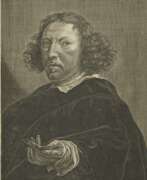

Herman Saftleven the Younger was a Dutch artist of the Golden Age who was Dean of the Guild of St. Luke in Utrecht.
Herman Saftleven the Younger was born into a creative family. His father, Hermann Saftleven the Elder (c. 1580-1627), was the father of three artist sons, Hermann the Younger, Cornelis (1607-1681), and Abraham Saftleven (c. 1611/13 - 1646).
Saftleven the Younger was an extremely productive painter, draughtsman, and printmaker. He is known for his landscapes near rivers as well as scenes of people traveling in the woods.
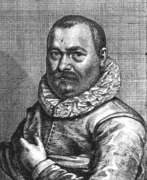

Roelant Savery was a Flanders-born Dutch Golden Age painter.
Savery primarily painted landscapes in the Flemish tradition of Gillis van Coninxloo, often embellished with many meticulously painted animals and plants, regularly with a mythological or biblical theme as background. He also painted multiple flower still lifes; bouquets in stone niches, sometimes with lizards such as Flowers with Two Lizards, insects or fallen petals and regarded as his best work.
His unique style of painting, related to the then reigning Mannerism, has been highly popular with collectors and can be found in many museums in Europe and North America. His preparatory drawings are also valued highly.
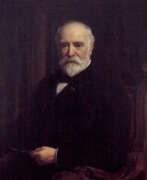

Hendrik Jacobus Scholten was a 19th-century painter from the Netherlands. He was a pupil of Petrus Franciscus Greive and Lambertus Johannes Hansen. In 1852 he became a member of the Royal Academy of Art in Amsterdam, and was a member of the Amsterdam art societies Arti et Amicitiae, Kunstbevorderend Genootschap V.W., and Vereeniging Sint Lucas. He was also a member of art societies in other towns. He became art curator of the Teylers Stichting in 1872, which manages the art collection of the Teylers Museum. In that capacity he wrote a catalog of the museum's collection, that was published in 1904. He painted several paintings that hang in the museum's galleries, as well as decorations in the Teyler's fundatiehuis, where he lived and worked from 1863 until his death.


Aert Schouman or Aart Schouman was an 18th-century painter, now better known as a glass engraver, from the Dutch Republic. He was a prolific and versatile Dutch painter, glass engraver, printmaker, collector and dealer, who produced still lifes, biblical and mythological themes, natural history studies, genre, historical and topographical works, portraits, sketches, etchings and mezzotints. He designed tapestries, painted wall-hangings and decorated objects such as fans, snuffboxes and even the glass windows of a magic lantern. From 1742 until 1792 he was head of the Dordrecht Guild of St. Luke, and in 1751 he became regent of the Hague drawing school associated with the Confrerie Pictura of The Hague. In 1736 he founded the "Brotherhood" of the Confrerie in The Hague, a fraternity of amateur art lovers from Dordrecht and environs, of which he was headman during the years 1752–1762.
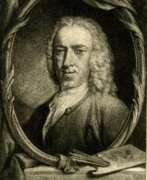

Aart Schouman was a Dutch painter, member of the Guild of St. Luke in Dordrecht and The Hague, and for many years was a leading painter in Zealand and the south of Holland. Most of his work consists of portraits and large paintings on wallpaper, he also did etchings and engravings on glass and copper and stained glass. Schaumann was interested in mythological and biblical themes, and later became famous for his watercolors of city and park landscapes and unique compositions with exotic birds, rare animals and plants.
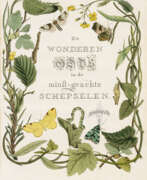

Jan Christiaan Sepp was a Dutch book publisher, printmaker and illustrator.
Jan Christiaan Sepp belonged to a dynasty of collectors, publishers and traders in printed books founded by his father, Christian Sepp (c. 1700-1775) in Goslar, Germany. Jan Christian Sepp is known for being the chief illustrator, creating the magnificent engravings for Cornelius Nozeman's highly prized work entitled Nederlandsche Vogelen (Birds of the Netherlands, 1770-1829). These copperplate engravings, superbly composed, meticulously engraved and hand-colored are of great value.
After Christian Sepp's death, the work of illustrating the five volumes was completed by his son, Jan Sepp. Each volume of this five-volume work of science and art contains 50 images of bird species, and each species is described on several pages.


